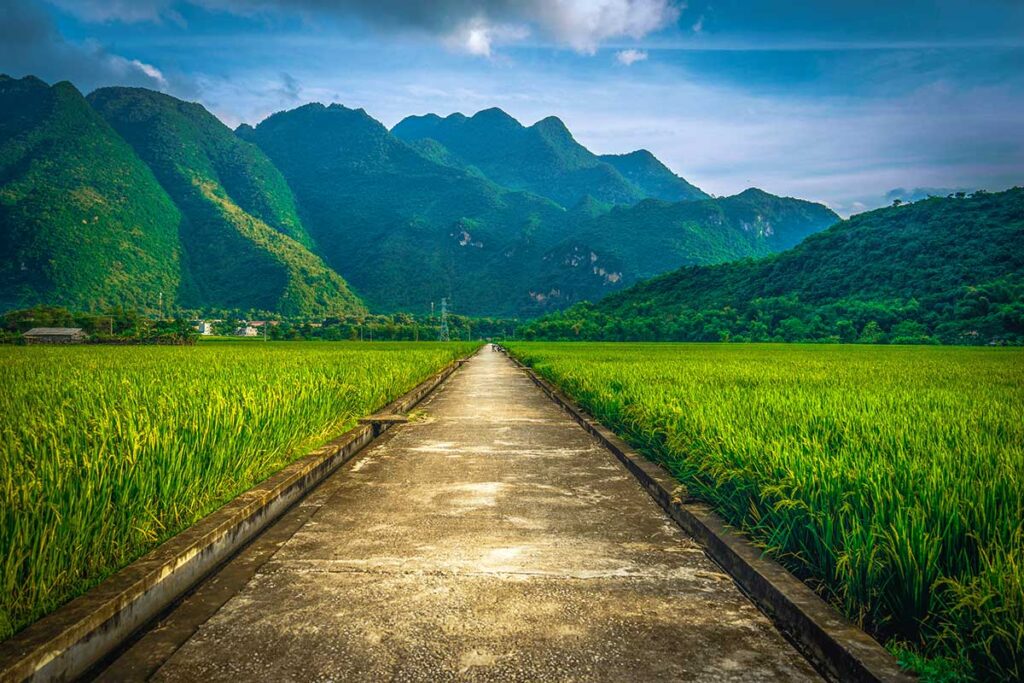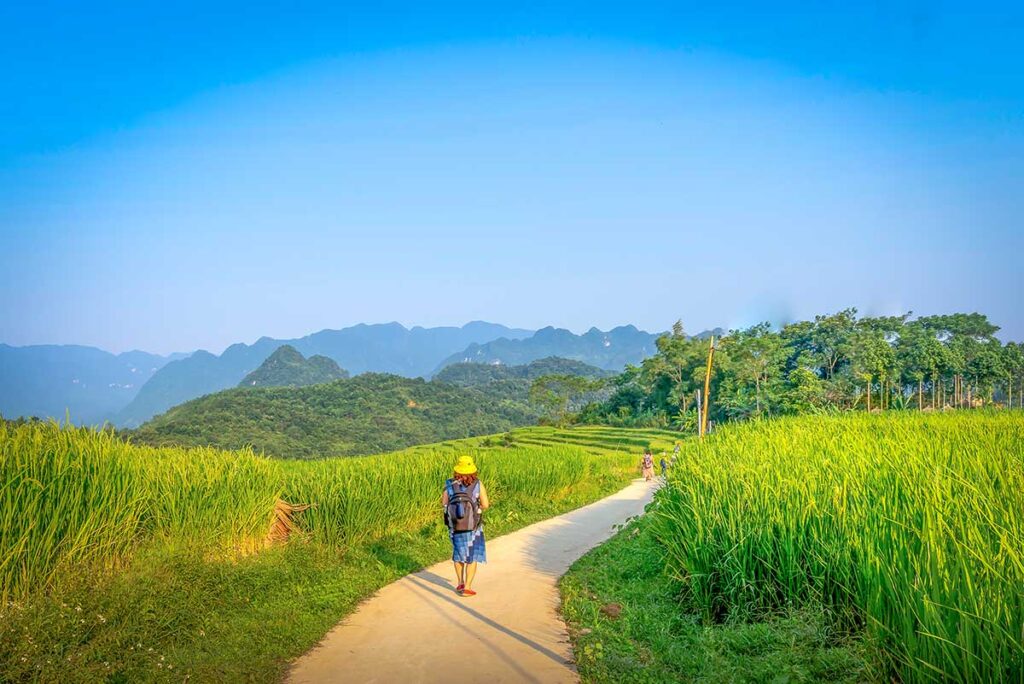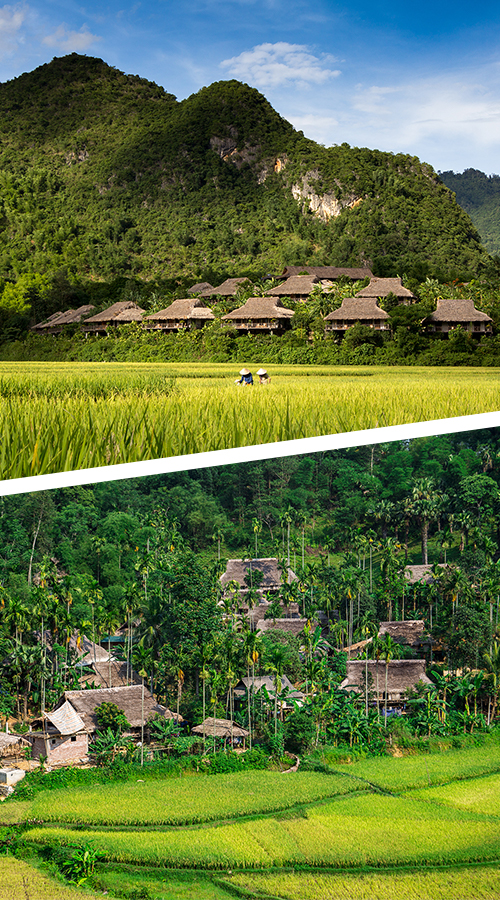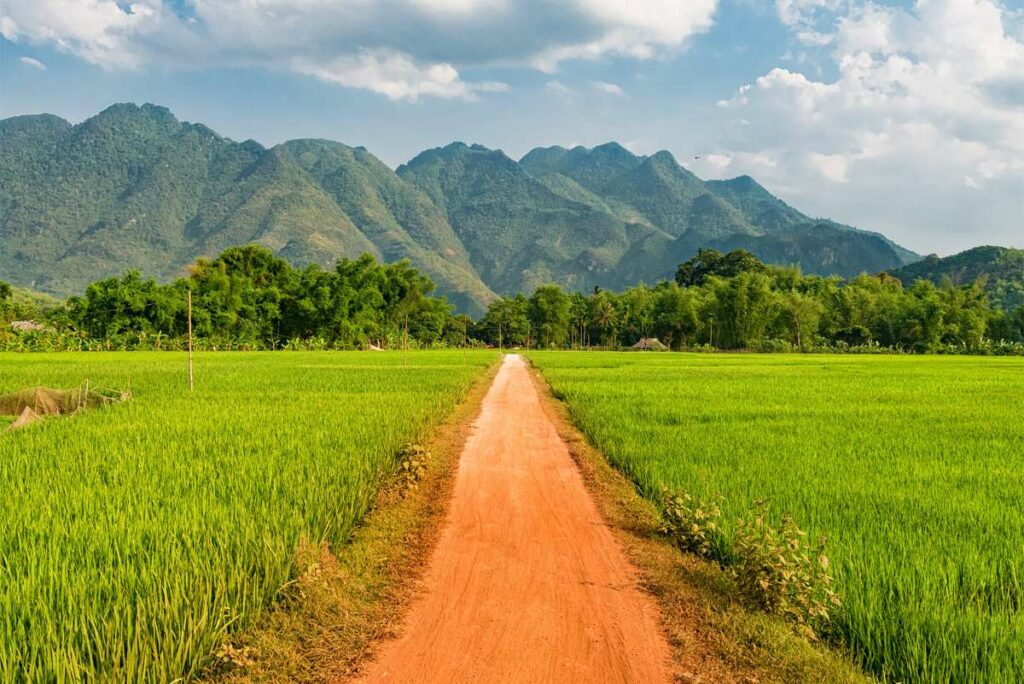What to expect when trekking in Mai Chau
Trekking in Mai Chau is a gentle, scenic experience that’s more about soaking in the landscape than taking on physical challenges. You won’t find marked trails or remote jungle paths here — instead, you’ll walk along quiet village roads, past rice paddies, and through ethnic Thai communities going about daily life.
Walking village to village on quiet countryside roads
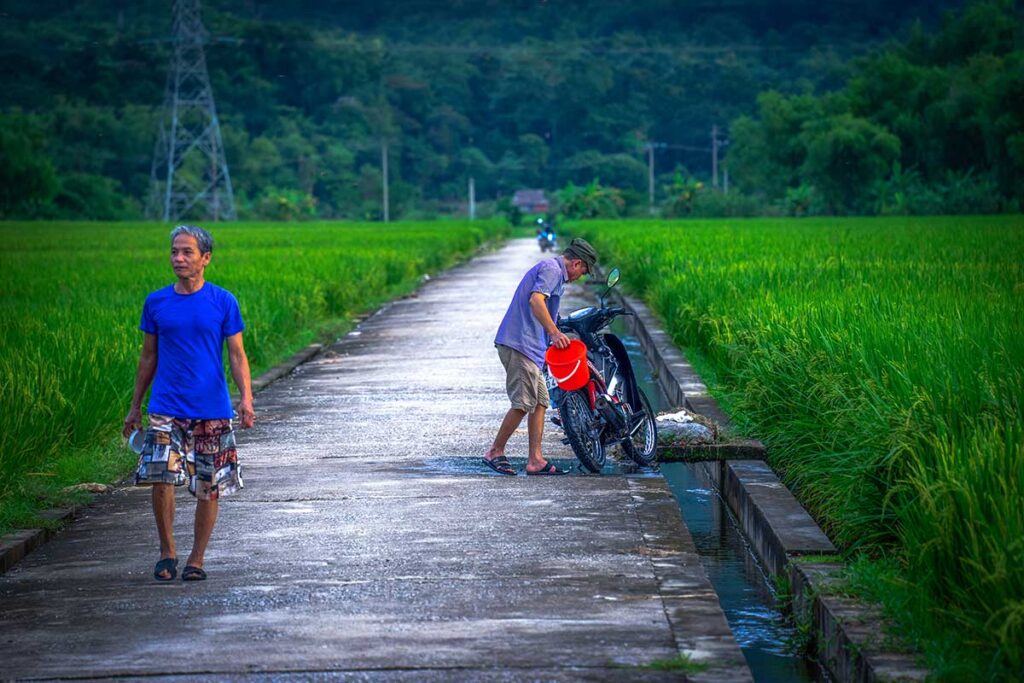
There are no formal hiking trails or mountain treks in Mai Chau. Most walking routes follow local roads — paved or concrete paths that connect the villages throughout the valley. While they aren’t built for tourism, they’re perfect for easygoing walks, with very little traffic apart from the occasional motorbike or bicycle.
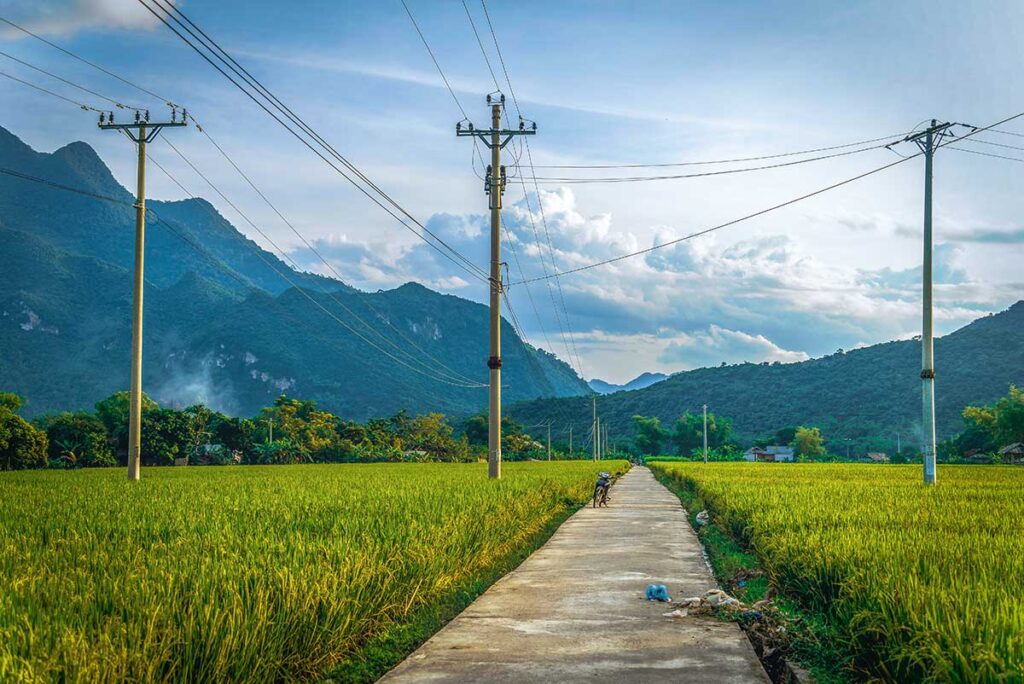
This makes Mai Chau ideal for travelers who want to explore at a relaxed pace without a guide. You can simply step out from your homestay and start walking.
Scenery & Ethnic Life
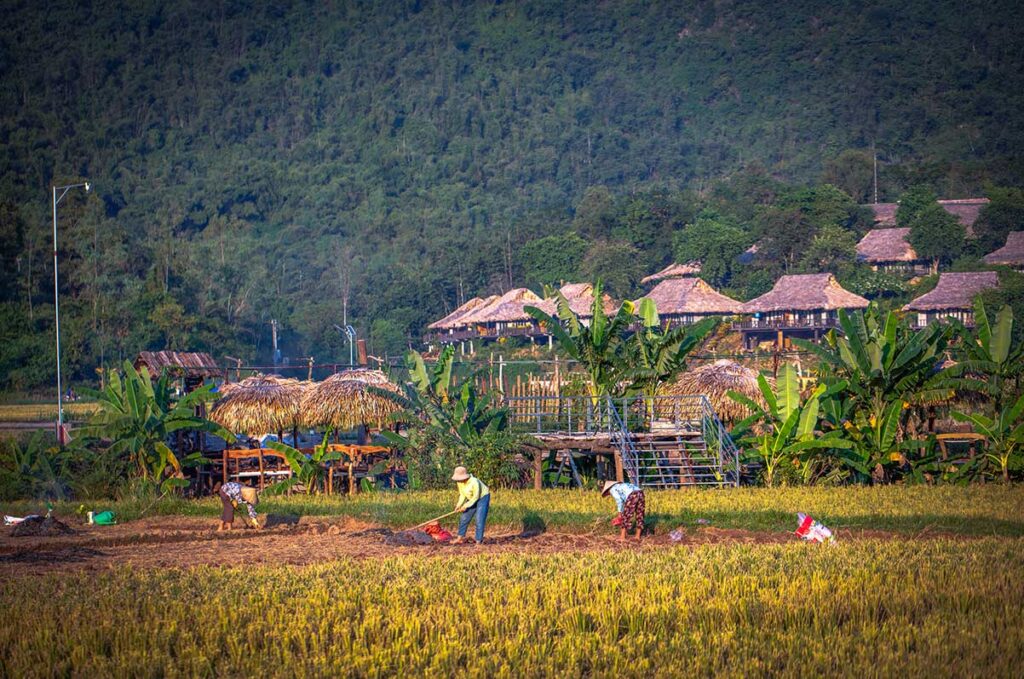
The views in Mai Chau are beautiful, especially during the green rice season or harvest. You’ll pass terraced fields, water buffalo in the mud, and traditional stilt houses nestled along the roadside. The villages are mostly home to the White Thai ethnic group, known for weaving, farming, and their warm — though often shy — hospitality.
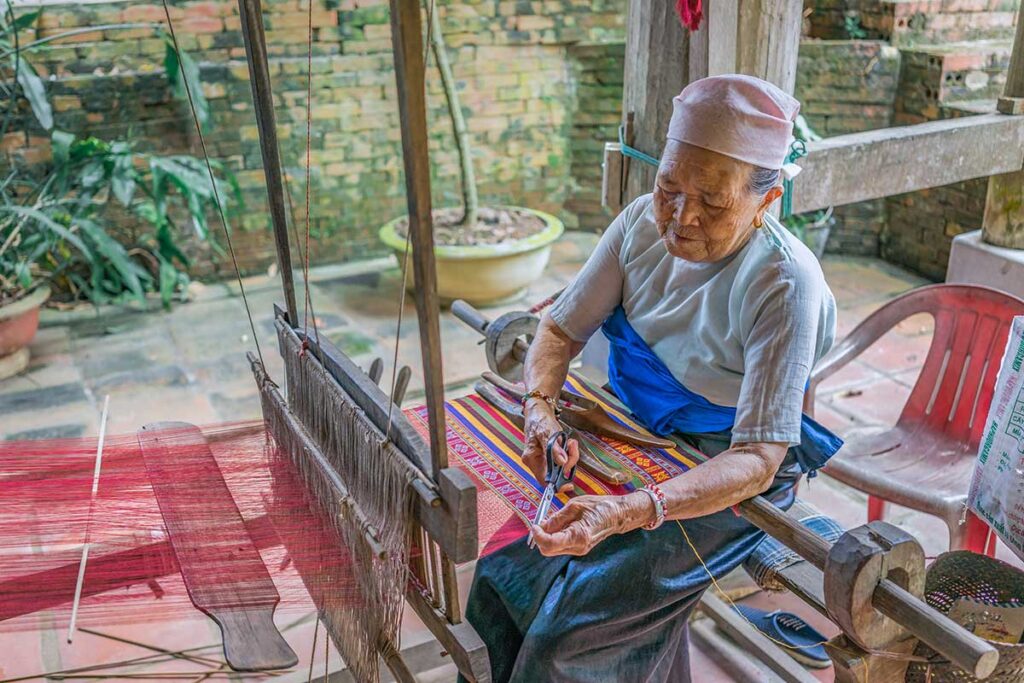
The valley is quite open, with wide views of distant hills and limestone cliffs. Don’t expect forested trails or jungle-like scenery — most routes are exposed, especially under the midday sun.
No Real Jungle Treks
If you’re hoping for rugged off-road trails or mountain trekking through dense forest, Mai Chau may not meet your expectations. The landscape is gentle and cultivated, with few natural paths beyond the main connecting roads.
For a more adventurous experience with real jungle treks, forest trails, and steeper terrain, Pu Luong Nature Reserve — about 1.5 to 2 hours away — is a much better fit. (We’ll cover that later in this guide.)
Where to walk in Mai Chau
You won’t find marked hiking trails in Mai Chau, but there are several walking routes that give you a feel for rural life and offer postcard views of the valley. These walks are easy to do on your own, and most start right from your homestay or lodge.
Here are a few of the best areas to explore on foot:
1. Lac Village to Pom Coong to Nhot or Na Phon
This is the most popular loop for walking in Mai Chau — a flat and scenic route through some of the valley’s most accessible villages. You’ll pass traditional stilt houses, rice paddies, and locals weaving or working in the fields. Expect a mix of paved and concrete roads, with plenty of chances to stop for a drink or take photos.
2. Mai Hich and Buoc Village
For a quieter experience, head out to Mai Hich or Buoc Village, located further away from the main tourist area. These villages see fewer visitors and offer a more laid-back atmosphere. The roads are similar — still easy to walk — but the surroundings feel more remote. You can reach them by bike or car, then explore on foot once you’re there.
3. Chieu Cave Walk
If you’re looking for a bit more physical activity, Chieu Cave offers a short but steep climb — around 1,200 steps straight up to a limestone cave with panoramic views over the valley. It’s not a jungle trek, but it adds variety to your stay and makes for a rewarding outing in the late afternoon.
Self-guided walks or with a guide?
Most people exploring Mai Chau do so on their own — and that’s perfectly fine. The village roads are easy to follow, paved or concrete, and connect directly to homestays, cafes, and local weaving workshops. You can find all of these roads on Google Maps, so it’s easy to follow a route or create your own Mai Chau hiking experience as you go. No guide or special navigation tools needed — just pick a direction and enjoy the scenery.
If you’re looking for something more off the usual route — such as walking through farmland, smaller dirt paths, or less-visited villages — it is sometimes possible to go with a local guide. These kinds of walks aren’t common or widely advertised, and they’re not offered as fixed “trekking tours,” but a few accommodations or local contacts may be able to help arrange something more rural or custom if you ask in advance.
In general, though, Mai Chau is designed for self-guided exploring, and that’s part of what makes it so relaxing. Just step outside and follow the small roads — you’ll find plenty to see without needing a formal tour.
Alternative: Cycling in Mai Chau
So if trekking in Mai Chau is more of a gentle countryside walk, how do most people explore the area? The answer is simple: by bicycle.
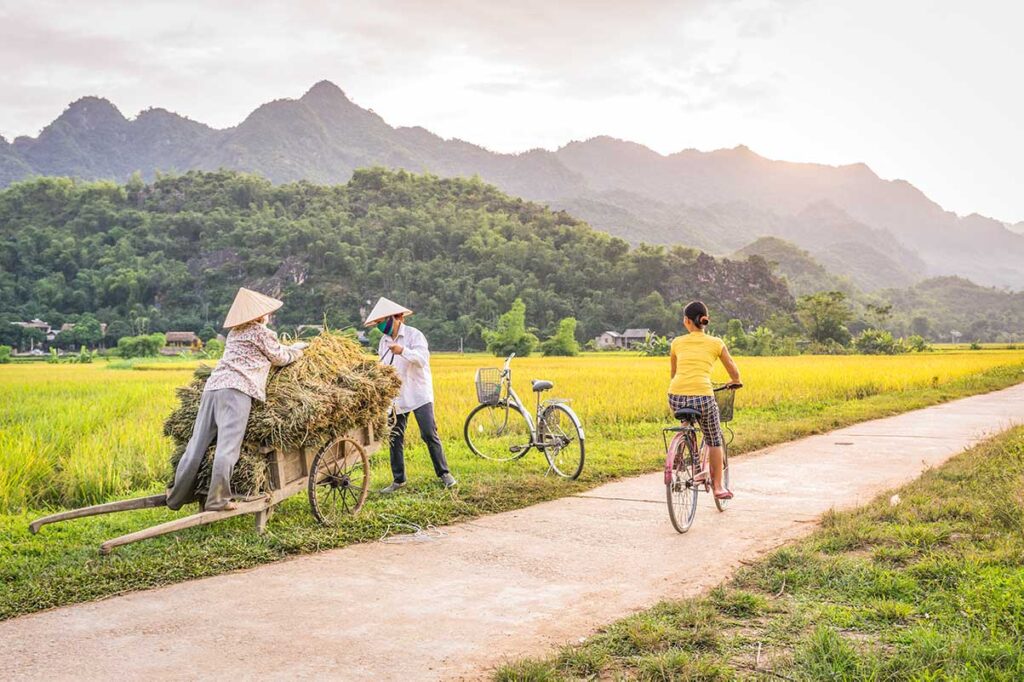
Cycling is the most popular way to discover Mai Chau’s villages and landscapes. The roads are flat, quiet, and scenic — perfect for a slow ride through rice fields and stilt house communities. It’s easy to stop wherever you like, chat with locals, or take photos along the way.
Almost every homestay and lodge in Mai Chau offers free or inexpensive bike rentals, and you can easily spend a full day cycling from one village to the next at your own pace. With such calm roads and open views, it’s no surprise that Mai Chau is considered one of the best places in Vietnam for relaxed countryside cycling.
Read more in our dedicated guide: Cycling in Mai Chau
Trekking day tour to Pu Luong from Mai Chau
If you’re looking for a more adventurous trekking experience than what Mai Chau offers, a day trip to Pu Luong is a great option. It’s a larger nature reserve just next door, with forested trails, mountain views, and more remote villages.
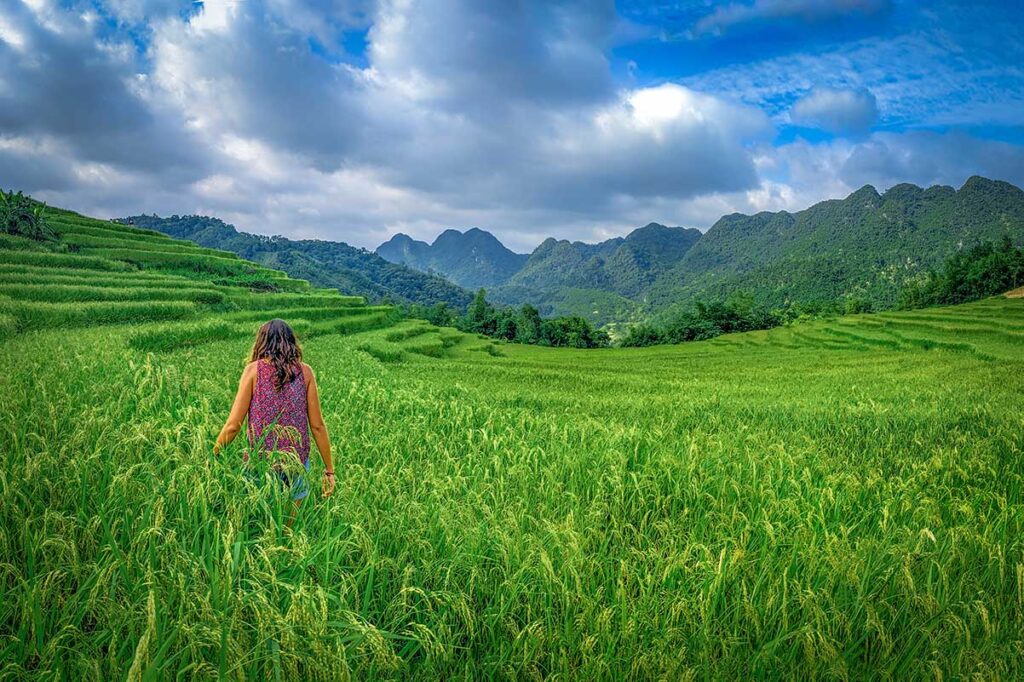
Expect a drive of 45 to 90 minutes, depending on where the trek begins. It does reduce your actual hiking time, but the drive itself is scenic — with rice terraces, mountain passes, and viewpoints along the way.
Most day tours include:
- A stop at one or two panoramic viewpoints over Pu Luong Nature Reserve
- A visit to a remote ethnic village like Hieu or Kho Muong
- A short trek through rice terraces or forested paths
- A local lunch in a stilt house
- Optional activities like bamboo rafting or swimming at a waterfall
Each tour is different, so it’s best to check the details when booking — but even with limited time, it gives you a real taste of Pu Luong’s landscape and culture.
Want more details? Read our full guide: Trekking in Pu Luong.
Or check out our day tour from Mai Chau to Pu Luong, which includes trekking, local lunch, and optional activities like bamboo rafting:
Pu Luong Nature Reserve Private Day Tour from Mai Chau
- Experience Scenic trekking, local villages, and bamboo rafting in Pu Luong’s nature.
- Includes Private guide, round-trip transfer from Mai Chau, lunch, and all activities.
Add-On or Alternative: Stay in Pu Luong instead
If you’re really into trekking, a day trip to Pu Luong might not be enough. The reserve is large, and some of the best treks take more time than a quick visit allows.
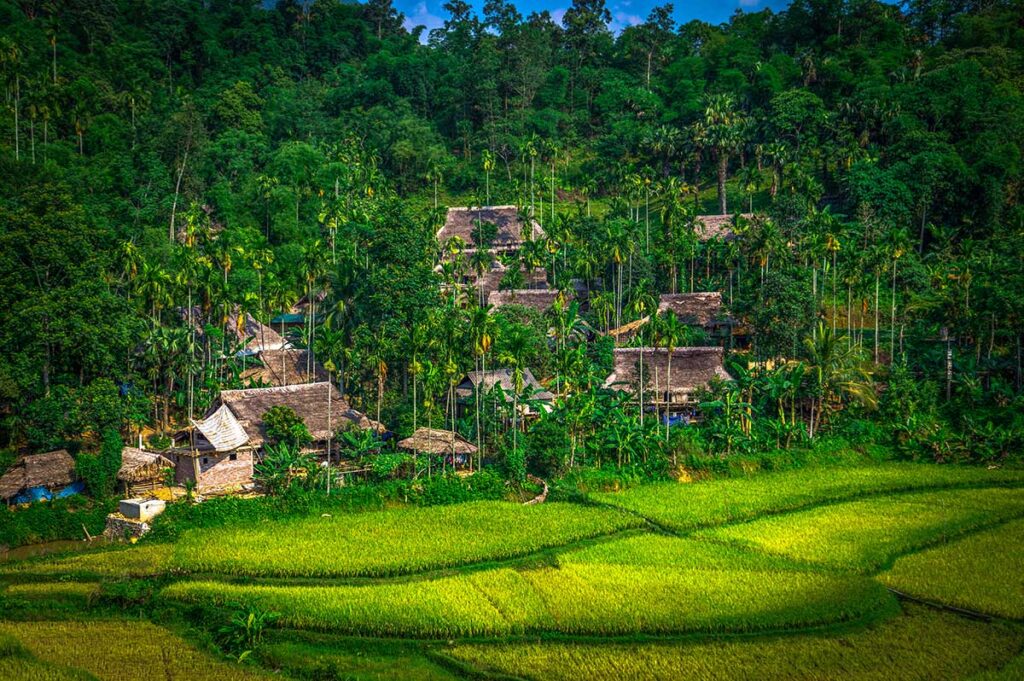
If trekking is a priority, consider spending at least one or two nights in Pu Luong. That way, you can take on longer hikes, explore different parts of the reserve, and enjoy the peaceful atmosphere without rushing.
You can:
- Visit both Mai Chau and Pu Luong in one trip — for example, one night in each
- Skip Mai Chau entirely and base yourself fully in Pu Luong for more remote trekking experiences
Pu Luong offers mountain treks, scenic rice terraces, quiet ethnic villages, bamboo rafting, and a much more off-the-grid feel than Mai Chau.
Learn more in our guide: Pu Luong travel guide
Or take a look at our Mai Chau + Pu Luong 3-Day Tour — a perfect combo if you want to experience both places:
Mai Chau & Pu Luong Nature Reserve 3 Days Exploration
- Experience Cycle through Mai Chau and trek remote trails in Pu Luong over 3 days.
- Includes All transfers from Hanoi, local guide, meals, and accommodation.
Tips for Trekking in Mai Chau
Mai Chau trekking is usually easy and flexible, but it still helps to prepare — especially with the open terrain, warm climate, and lack of shade. Whether you’re on a short village walk or trying a longer Mai Chau hiking route, here are a few tips to make your experience better.
Best time to go
The best time for trekking in Mai Chau is during spring (April to June) and autumn (September to November), when the weather is dry and the scenery is at its best. Expect lush green fields in spring and golden rice in the fall.
In the summer, walking can be hot and humid. Winter is cooler and still suitable for light hikes, especially in the valley.
What to Bring
Even though most Mai Chau treks are not difficult, it’s good to come prepared. Bring:
- Comfortable walking shoes (sneakers or trainers are fine)
- Sun protection — hat, sunscreen, long sleeves
- Reusable water bottle or daypack
- Light rain jacket if visiting during the summer months
Carry somecash
If you’re doing a self-guided Mai Chau hike, bring some small cash. Many villages have drink stalls or souvenir shops, but card payments are rare.
Plan your walk with breaks
Most trekking in Mai Chau happens in wide, open valleys with little shade. Plan to stop in small cafés or shaded rest spots along the way — especially helpful on warmer days.
Respect the Local Culture
Mai Chau trekking brings you into quiet ethnic minority villages, so it’s important to be respectful:
- Don’t enter homes unless invited
- Ask before photographing people up close
- Avoid stepping into rice paddies or private gardens
- Dress modestly, especially in smaller, less visited areas
